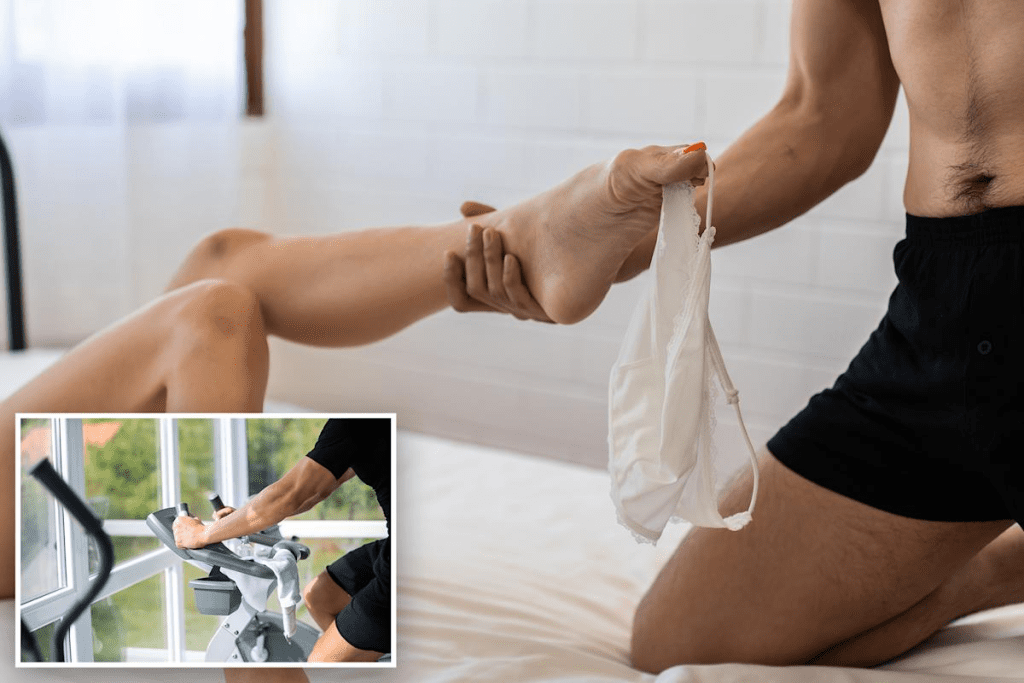Last Updated on October 31, 2025 by
Many simple exercises can greatly improve men’s health, like the “5-second prostate shrinking exercise.” This exercise is actually a reference to kegel exercises, which doctors often suggest to boost prostate health and ease urinary issues in men.

Kegel exercises involve tightening the pelvic floor muscles for a few seconds and then relaxing. Men should tighten these muscles for 3-5 seconds, relax for the same amount of time, and repeat this 10 times per set. They should do several sets every day.
Strengthening the pelvic floor muscles can greatly help with urinary incontinence and prostate health. At top hospitals like Liv, this is a key part of their treatment plans, showing its success.
We’re exploring the truth behind the “5-second prostate exercise.” It sounds simple, but is it really effective? Let’s sort out fact from fiction.
The claim of a “5-second prostate shrinking exercise” is not accurate. No single move can shrink the prostate. But, pelvic floor exercises, or Kegel exercises, can strengthen the muscles around the bladder and prostate. This might help with some prostate problems. For more on Kegel exercises, check out this resource.

Pelvic floor training strengthens muscles that support the pelvic organs. It’s not just for women; men can benefit too, helping with prostate health. Regular Kegel exercises can improve bladder control and possibly reduce prostate issues.
Men with urinary incontinence, prostate enlargement, or other prostate issues can benefit. These exercises are simple and can be done anywhere. Adding Kegel exercises to your daily routine can help improve prostate health.
Kegel exercises are key for men wanting to boost their prostate health. These exercises strengthen muscles that support the bladder, prostate, and rectum. This can greatly improve bladder control and prostate health.

The pelvic floor is made up of muscles, ligaments, and fascia. It supports the bladder, prostate, and rectum. Strengthening these muscles through Kegel exercises can lead to better bladder control and sexual health.
“Strengthening the pelvic floor muscles is a proactive step towards maintaining prostate health and overall wellbeing,” as emphasized by healthcare professionals. The anatomy of the pelvic floor is complex, with muscles and connective tissue supporting pelvic organ function.
Kegel exercises strengthen muscles around the prostate. This can improve prostate health, reduce BPH symptoms, and enhance urinary continence. Regular exercises also boost sexual health by improving erectile function and pelvic floor stability.
The benefits of Kegel exercises for prostate health are wide-ranging. They help manage and prevent prostate issues, improve bladder control, and enhance sexual function. Kegel exercises are a simple, non-invasive way to improve prostate health and overall quality of life for men.
While Kegel exercises are the same for both men and women, the focus can differ. Men do Kegels for prostate health, urinary control, and sexual function. Women do them for bladder control, post-childbirth, and sexual health.
Despite these differences, the main goal of Kegel exercises is the same for both genders. It’s to strengthen the pelvic floor and improve its function. We highlight Kegels’ importance for men’s prostate health, but also their benefits for overall pelvic health.
To get the most out of Kegel training, it’s essential to understand the proper technique. The 5-second Kegel exercise is a straightforward yet effective method for improving prostate health. By following a step-by-step guide, men can master this exercise and enjoy its benefits. We will walk you through the process, ensuring you can incorporate Kegel exercises into your daily routine with ease.
Locating your pelvic floor muscles is the first step in performing Kegel exercises correctly. To identify these muscles, try stopping the flow of urine mid-stream or imagine the muscles used to hold in gas. Once you’ve located them, you can proceed with confidence, knowing you’re targeting the right muscles.
The basic 5-second contraction technique involves contracting your pelvic floor muscles for 5 seconds, then releasing them for 5 seconds. Repeat this cycle several times, gradually increasing the number of repetitions as you build strength. It’s important to focus on the quality of each contraction, ensuring you’re engaging the correct muscles.
Creating a progressive training schedule is vital for maximizing the benefits of Kegel exercises. Start with a manageable number of repetitions and gradually increase the intensity and frequency over time. Consistency is key, so aim to perform Kegel exercises at the same time daily, making it a habit.
Incorporating Kegel exercises into your daily activities can make it easier to maintain a consistent practice. You can perform Kegels while driving, watching TV, or even during work. The flexibility of Kegel exercises allows you to integrate them seamlessly into your daily routine, ensuring you don’t miss a day.
By following these steps and maintaining a consistent practice, men can effectively improve their prostate health through Kegel exercises. Remember, the key to success lies in proper technique and consistent practice.
Regular pelvic floor training is a game-changer for men’s health. Studies show that kegels pelvic floor exercises for men are highly effective. The results are impressive.
One key benefit is the drop in urinary incontinence. Men doing male kegel exercises see a 100% improvement, mainly after prostate surgery.
This is because the pelvic floor muscles get stronger. These muscles control urination. By doing male kegel exercises daily, men lower their risk of incontinence.
Regular pelvic floor training also helps with BPH symptoms. It strengthens muscles around the prostate. This reduces BPH discomfort.
Men doing these exercises see a drop in BPH symptoms. This boosts their quality of life.
Regular pelvic floor training also boosts sexual function and erectile health. Strengthening the pelvic floor muscles improves erectile function. This enhances overall sexual health.
Adding male kegel exercises to daily routines can greatly improve sexual well-being. It leads to a healthier, more fulfilling sex life.
For men after prostate surgery, pelvic floor training is key. Kegels pelvic floor exercises for men help regain urinary control. They improve recovery outcomes.
By including male kegel exercises in their recovery, men recover faster. They can get back to their normal activities sooner.
Adding Kegel exercises to your daily routine can greatly improve prostate health and urinary control. The 5-second Kegel is a simple yet powerful way to strengthen pelvic floor muscles. These muscles are key to supporting prostate health.
Kegel exercises, or “fitness kegel,” can also help with urinary incontinence and sexual function. They improve overall quality of life. By learning what Kegel workouts are and how to do them, men can actively care for their prostate health.
We suggest starting the 5-second Kegel exercise in your daily routine. It’s best to do it while exercising, driving, or during work breaks. Being consistent is important to see the benefits of Kegel exercises. Regular practice can lead to better prostate health and overall well-being.
By making Kegel exercises a daily habit, men can manage their prostate health and enhance their life quality. Start with the 5-second Kegel and gradually increase the time and frequency as your muscles get stronger.
Kegel exercises strengthen the muscles around your bladder, prostate, and rectum. They involve contracting and releasing these muscles. The “5-second prostate shrinking exercise” is a specific Kegel technique that lasts 5 seconds.
Men with incontinence, prostate issues, or after surgery can benefit. They also help improve prostate health and overall well-being.
Try stopping urine flow mid-stream or tightening muscles to prevent gas. Contracting muscles around your anus also helps find the right muscles.
Contract your pelvic floor muscles for 5 seconds, then release for 5 seconds. Repeat this for the recommended number of times.
Do Kegel exercises several times a day, increasing intensity and frequency. Results vary, but consistent practice can improve incontinence and prostate health in weeks to months.
The basic principle is the same, but muscles targeted and techniques differ. Men focus on muscles supporting the prostate and bladder. Women target muscles for the bladder and uterus.
Yes, Kegel exercises can alleviate BPH symptoms like frequent urination. They strengthen pelvic floor muscles and improve bladder control.
Yes, Kegel exercises can enhance sexual function and erectile health. They strengthen pelvic floor muscles and improve blood flow to the genital area.
Yes, Kegel exercises can help after prostate surgery. They aid in restoring bladder control and improving prostate health.
Do Kegel exercises during daily tasks like sitting at your desk or watching TV. This makes it easier to practice regularly.
The American Urological Association. (n.d.). BPH (enlarged prostate). Retrieved from https://www.urologyhealth.org/urologic-conditions/benign-prostatic-hyperplasia-(bph
Subscribe to our e-newsletter to stay informed about the latest innovations in the world of health and exclusive offers!